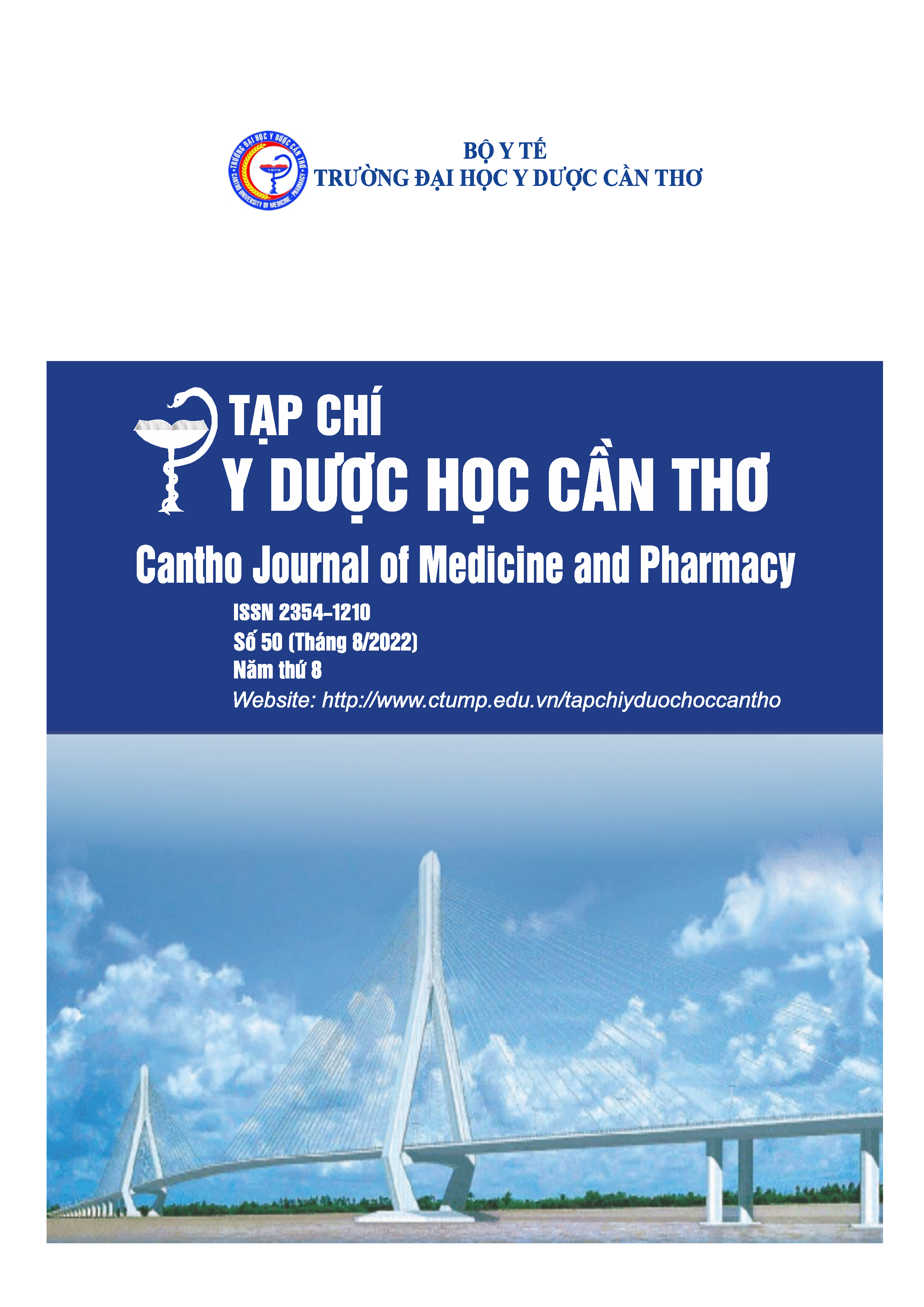THE SPIROMETRY CHARACTERISTICS AND SOME FACTORS ASSOCIATED WITH RE-EXACERBATION OF ACUTE ASTHMATIC CHILDREN AGED 6–15 YEARS OLD AT CAN THO CHILDREN'S HOSPITAL
Main Article Content
Abstract
Background: Asthma is a serious global health issue that affects people of all ages. Objectives: The purpose of this study is to describe the pulmonary function characteristics via spirometry as well as determine some factors associated with asthmatic re-exacerbation. Materials and methods: A cross-sectional descriptive study was performed on patients from 6 to 15 years of age with acute asthma hospitalized at Can Tho Children's Hospital from 1/2021 to 5/2022. Results: A total of 60 asthmatic patients were included in the study. The mean age of asthmatic patients was 8.8±1.9 (years), and the male sex accounted for 68.3%. The average forced expiratory volume in the first second (FEV1) was 68.9±21.1% predicted; forced vital capacity (FVC) was 86.5±20.9% predicted; FEV1/FVC was 69.9±13.0%; forced expiratory flow at 25–75% (FEF25–75) was 44.5±21.1% predicted. When comparing the characteristics of pulmonary ventilation function according to the severity of acute asthma, we found statistically significant differences in FEV1 (p=0,002), FVC (p=0,045), FEV1/FVC (p=0.002) and FEF25-75 (p=0.007) between the groups. We recorded that 13.3% of patients had a re-exacerbation of asthma. Patients with re-exacerbation had significantly lower FEV1, FEV1/FVC, and FEF25-75 than those without. Severe acute asthma (p=0.002), FEV1 (p=0.041), FEV1/FVC (p=0.026), and FEF25-75 (p=0.025) were found to be significantly associated with acute asthma re-exacerbation. Conclusion: In the present study, there were significant differences when comparing these mentioned parameters between the groups following the serverity of acute asthma. This study revealed that severe acute asthma, FEV1, FEV1/FVC, FEF25-75 were significantly associated with asthma re-exacerbation.
Article Details
Keywords
Spirometry, asthma, children
References
2. Bộ Y tế (2016), Hướng dẫn chẩn đoán và điều trị hen trẻ em dưới 5 tuổi, Quyết định số 4888/QĐ-BYT ban hành ngày 12/09/2016, Hà Nội.
3. Mai Thị Kim Cương, Lê Hoàng Sơn, Bùi Quang Nghĩa và cộng sự (2021), “Nghiên cứu lâm sàng, cận lâm sàng hen phế quản có nhiễm Mycoplasma pneumoniae ở trẻ 6-15 tuổi tại Bệnh viện Nhi đồng Cần Thơ năm 2019-2021”, Tạp chí Y Dược học Cần Thơ, số 38, tr.115-121.
4. Huỳnh Thúy Hằng, Cao Thị Vui, Trương Thành Nam (2020), “Nghiên cứu đặc điểm lâm sàng, cận lâm sàng và đánh giá kết quả điều trị hen phế quản dị ứng trẻ em từ 6-15 tuổi tại Bệnh viện Nhi đồng Cần Thơ năm 2019-2020”, Tạp chí Y Dược học Cần Thơ, số 31, tr.41-47.
5. Trần Thúy Hạnh, Nguyễn Văn Đoàn, và cộng sự (2012), “Một số đặc điểm dịch tễ học của hen phế quản ở người trưởng thành Việt Nam”, Tạp chí Y học lâm sàng, 65, tr.46-50.
6. Phạm Thị Quỳnh Vân, Hoàng Đức Hạ, Nguyễn Ngọc Sáng (2020), “Đặc điểm lâm sàng và cận lâm sàng của hen phế quản ở trẻ em tại Bệnh viện Trẻ em Hải Phòng”, Tạp chí Y học Việt Nam, số 2, tr.129-133.
7. Global Initiative for Asthma (2019), Global Strategy for Asthma Management and Prevention.
8. Gallucci M., Carbonara P., Pacilli A.M.G., et al. (2019), “Use of Symptoms Scores, Spirometry, and Other Pulmonary Function Testing for Asthma Monitoring”, Frontiers in pediatrics, 7(54), pp.1-12.
10.Major S., Vézina K., Tse S.M. (2021), “Lung Function of Children Following an Intensive Care Unit Admission for Asthma”, Pediatric Allergy, Immunology, and Pulmonology, 34(1), pp.1-6.
11.Paull K., Covar R., Jain N., et al. (2005), “Do NHLBI lung function criteria apply to children? A cross-sectional evaluation of childhood asthma at National Jewish Medical and Research Center”, 1999-2002, Pediatric Pulmonology, 39(4), pp.311-317.
12.Reddel H.K., Taylor D.R., Bateman E.D., et al. (2009), “An official American Thoracic Society/European Respiratory Society statement: asthma control and exacerbations: standardizing endpoints for clinical asthma trials and clinical practice”, American Journal of Respiratory and Critical Care Medicine, 180(1), pp.59-99.
13.Sherenian M.G., Wang Y., Fulkerson P.C. (2015), “Hospital admission associates with higher total IgE level in pediatric patients with asthma”, The Journal of Allergy and Clinical Immunology: In Practice, 3(4), pp.602-3.e1.
14.Tan C.C., McDowell K.M., Fenchel M., et al. (2014), “Spirometry use in children hospitalized with asthma”, Pediatric Pulmonology, 49(5), pp.451-457.
15.The Global Asthma Network (2018), The Global Asthma Report 2018, Auckland, New Zealand.
16.van Dalen C., Harding E., Parkin J., et al. (2008), “Suitability of forced expiratory volume in 1 second/forced vital capacity vs percentage of predicted forced expiratory volume in 1 second for the classification of asthma severity in adolescents”, Archives of Pediatrics and Adolescent
Medicine, 162(12), pp.1169-1174.


